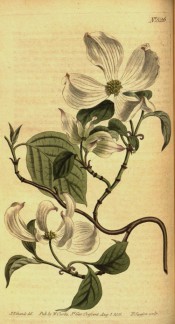Cornus florida L.
Deciduous shrub or small tree with oval leaves to 15cm long, turning red in Autumn, small yellow-green flowers in small heads, surrounded by showy white to pink bracts, followed by pendant, strawberry-like fruit. To 12m. [RHS, Hortus]. There are many garden varieties.
Horticultural & Botanical History
Introduced to Britain in 1731. [JD]. ‘In the temperate regions of North-America this tree is much spoken of for its beauty, rising from ten to twenty feet in height, agreeable in its foliage, and covered in the Spring and early part of the Summer with a profusion of white or sometimes rose-coloured flowers; nor does it want beauty even in the gloomy months of Winter, from the quantity of red berries which it bears, and which at that season afford sustenance to the finest warbler of the woods of America, the celebrated mocking bird (Turdus Orpheus) emphatically called in the Indian language, the Hundred-Tongued Bird. […] It grows in the Duke of Marlborough’s garden at Sion-Hill, is about sixteen feet high, and spreads at least eighteen, has a straight trunk about six feet in length before it branches, measuring two feet in circumference a yard from the ground; the bark much resembles an elm of the same size. This beautiful tree has flowered freely for many years past, but unfortunately produces no fruit. Its age is unknown, but as we have evidence of its being cultivated at Chelsea by Miller, in 1739, it is probable that its origin may not be of much later date. We are much obliged to Mr. Whitman, his Grace’s Gardener, for sending us notice of this tree, and favouring us with specimens and with the above dimensions.’ [BM t.526/1801].
‘Cornus florida is distributed from eastern Massachusetts to southern Ontario and southwestern Missouri, and southward to central Florida and the valley of the Brazos River in Texas, and reappears on the Sierra Madre and several of the other mountain ranges of eastern and southern Mexico. Comparatively rare at the north, the Flowering Dogwood is one of the commonest and most generally distributed inhabitants of the deciduous forests of the middle and southern states, growing under the shade of taller trees in rich well-drained soil, and from the coast nearly to the summits of the high Alleghany Mountains.
The wood of Cornus florida is heavy, hard, and strong, tough and close-grained, with a satiny surface susceptible of receiving a beautiful polish; it contains numerous conspicuous medullary rays, and is brown, sometimes changing to shades of green and red, with lighter colored sapwood composed of thirty to forty layers of annual growth. The specific gravity of the absolutely dry wood is 0.8153, a cubic foot weighing 50.81 pounds. It is largely used in turnery, for the bearings of machinery, the hubs of small wheels, barrel-hoops, the handles of tools, and occasionally for engravers’ blocks. The bark, especially that of the roots, which contains a bitter principle, cornin or comic acid, is astringent and slightly aromatic, and is occasionally used in the form of powder, decoctions, or fluid extracts, in the treatment of intermittent and malarial fevers, and in homoeopathic practice.
The Flowering Dogwood is one of the most beautiful of the small trees of the American forests, which it enlivens in early spring with the whiteness of its floral leaves and in autumn with the splendor of its foliage and the brilliancy of its fruit. No tree is more desirable in the garden or park in regions where the summer’s sun is sufficiently hot to insure the production of its flowers through the perfect development of the branchlets. A variety with pendulous branches, discovered a few years ago in the forests of Maryland, and one with bright red involucral scales are now often cultivated.
The first published account of Cornus florida appeared in the Phytographia of Plukenet in 1691; his information was probably derived from John Banister, the English missionary in Virginia, although there is no mention of the Flowering Dogwood in Banister’s printed catalogue of Virginia plants. According to Loudon, it was cultivated in England in 1730 by Thomas Fairchild, and a few years later by Philip Miller in the Physic Garden at Chelsea.’ [Sargent – Silva of North America vol.5, p.67/1893].
History at Camden Park
Cornus florida is marked with a ‘c’ in an 1836 edition of Loddiges’ catalogue held at Camden Park [CPA]. In William Macarthur’s code, used and explained elsewhere, this means grown at Camden. It is almost certain that it was grown in the gardens around this time but may have been short lived as it did not appear in the catalogues.
Notes
Published Mar 31, 2010 - 04:45 PM | Last updated Mar 31, 2010 - 04:53 PM
| Family | Cornaceae |
|---|---|
| Category | |
| Region of origin | Eastern North America |
| Synonyms |
|
| Common Name | Flowering dogwood |
| Name in the Camden Park Record |
Cornus florida 1843 |
| Confidence level | high |


